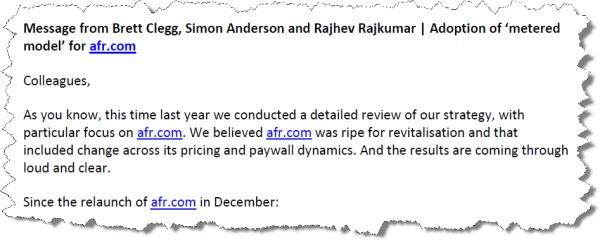The Australian Financial Review‘s hard paywall experiment is officially dead, buried and cremated. The Fairfax business daily will join its broadsheet siblings by adopting a New York Times-style metered model in 2013 — a move that follows earlier decisions to slash subscription costs and make more stories available for free.
The decision, announced to staff on Monday in an email sent by Financial Review Group CEO Brett Clegg, sets the scene for a fascinating battle between Fairfax and News Limited next year as the bitter rivals pursue digital strategies that are subtly, but importantly, different. By this time next year, we should have a good idea who backed the right horse.
The porous “metered” system adopted by Fairfax is increasingly in vogue with publishers around the world. The theory is that by allowing readers to access a set number of articles a month — usually 10-15 — you can continue to attract casual browsers (and the advertising dollars they bring) to your site while milking money out of more loyal readers.
The New York Times has signed up over 500,000 registered subscribers who pay between $15 and $25 a month. Web traffic has remained steady despite predictions it would plummet; according to Business Insider, the site actually picked up half a million visitors after introducing a paywall in March 2011.
Clegg told Crikey this morning: “What I like about the metered model is that you can protect — even build — casual usage while also driving highly-engaged readers beyond the paywall.”
By contrast, News Limited is sticking to the more rigid “freemium” model in which some stories are made available for free while others are locked up for subscribers. The Australian, targeted at affluent readers, has adopted a relatively strict model, with most of the stories on its homepage available only to its 30,000 subscribers. The mass-market Herald Sun tends to make general and breaking news available for free while charging readers for access to its high-profile opinion columnists and premium AFL and crime content. Web traffic to both sites has declined significantly since the paywalls went up: the number of average daily unique broswers has fallen by 27% year-on year for both sites according to Nielsen data.
The hard paywall approach adopted by News Corporation’s The Times in the UK — and championed by former AFR CEO Michael Gill as late as November last year — is now out of favour around the world. Traffic to The Times famously declined by around 90% after its almost unpenetrable paywall went up.
Clegg told Crikey that London-based consultants LEK recommended late last year that The Fin move to a metered model when it reached the tipping point of 700,000 unique browsers a month. He says unique visits to the site topped 1 million last month, meaning the paper can go metered almost two years ahead of schedule.
The Fin’s new head of product, ex-NY Times digital supremo Danielle Harmer, will oversee the transition from a freemium to metered model.
“Part of her mandate will be reviewing these options, including number of stories per month as well as whether some categories are always locked,” Clegg said. “Street Talk is a case in point. The equivalent of LEX in the Financial Times is always locked despite them working under a meter.”
Clegg said the AFR subscription price is expected to remain at $680 a year — a price 40% lower than a year ago but still far higher than, for example, The Australian‘s offering.








Hooray! The Australian Financial Review’s web presence was dreadful.
the UK Times website is aggressively off putting so there is a good lesson there. It’s good to see the AFR has seen sense.
This isn’t rocket science despite the muddle so many publications have got themselves into. Sure the mechanics may require experts but people haven’t changed : the modern day equivalent of going into the newsagent and flipping through a publication to see if you wish to purchase, is surfing the net and finding an on-line publication that appeals.
A range of digital options should have been bleeding obvious – such as purchasing one-off articles or a one off read of the latest copy, subscription and so on.
I agree Peter.
One off purchases is just what I seek, but apparently the customer isn’t always right.
Fairfax have taken to avoiding the topic. But it does appear that Gill’s assertions about profit were right.
Might be helpful to all concerned if Crikey went metered as well…the digital equivalent of borrowing your friends copy until you realise you use it so much you might as well buy your own.